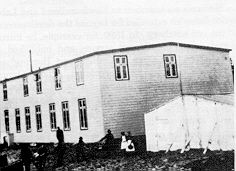
INTRODUCTION
During the mid-1880's, fish landings were declining in Newfoundland, and there was increasing competition from both France and Norway in the island's traditional markets. (1) In an attempt to redress this situation, the Government of Newfoundland appointed a Fisheries Commission in 1887 for the purpose of making enquiries into the "constitution and working of fisheries departments, in other countries, with the view to the establishment of a similar department." (2) This was considered especially important since it could not be determined if "our fisheries was advancing or declining, or what was their condition from year to year." (3) The fourteen man Commission of Inquiry was also to examine:
"The depressed condition of our fisheries, during the last few years, and the frequent and alarming failures, especially in our shore fishery, which have recently occurred, ... and to impress on all who are interested in the future of our fisheries the necessity of taking prompt and energetic means for their restoration and protections." (4)
This initiative was facilitated by the arrival in Newfoundland in July 1887 of Adolph Nielsen, an Assistant Inspector of Fisheries from Sandefjord, Norway. Nielsen was part of a two-man delegation sent by the Norwegian Department of Fisheries to examine methods and markets in North America and England, the other participant being Jens Dahl, Inspector of Salt Water Fisheries. The visit enabled Nielsen to meet the Commissioners, including Corresponding Secretary Moses Harvey, a member of a prominent St. John's family and also journalist, clergyman and amateur naturalist of some stature. (5) Nielsen particularly impressed Harvey with his description of how Norway had hatched some 67 million cod yolk sac fry in three years for restocking coastal waters. (6)
Methods for artificial propagation of marine fish fry had been developed in Norway by the marine zoologist G.O. Sars from 1864, and introduced experimentally to the United States around 1878. Experimental work by the American Fisheries Commission at Ten Pound Island near Gloucester, Massachussetts, subsequently led to development of a hatchery at Wood's Hole in 1885. The ideas were also adopted by Captain Gunder Dannevig, founder of the Flodevigen hatchery at Arendal, Norway, in 1882, and which produced its first cod yolk sac fry two years later. Nielsen knew Dannevig well, and was familiar with the operation of his hatchery. (7)
Moses Harvey thought that hatchery-produced fry could also be introduced into Newfoundland waters to improve local stocks and thus the fishery. (8) Consequently he asked Nielsen on his return home to prepare a report for the Commission on the operations of the Norwegian fisheries department and to recommend how such a department could be established in Newfoundland. Harvey was particularly concerned that this proposed department should also make a general study of the fisheries, and develop regulations to control fishermen's activities and thus revitalise the industry. (9)
Perhaps motivated by the possibility of new employment, Nielsen, in his Report of 25 October 1887, (10) suggested that the Government of Newfoundland appoint a Superintendent of Fisheries, preferably an individual "acquainted with both your own and your competitors method of catch and cure of fish." Priority tasks of the Superintendent would be to establish a cod hatchery and have the government introduce legislation to prevent the catching of young fish. (11)
No doubt influenced by this document, and a Report on the Flodevigen hatchery operations of 1886 also submitted by Nielsen, (12) the Commissioners "strongly urged the desirability of at once introducing the proper means for the artificial propagation of codfish, with the view of restocking our exhausted bays," (13) especially since:
"This island presents peculiar facilities for carrying out the propagation of cod fish in its deep and sheltered bays, which are specially adapted for the protection of the young fry, and in which, by artificial culture, vast multitudes of cod may be matured and their former abundance restored." (14)
The Commissioners also approved Nielsen's suggestion that a Superintendent should be hired who was a qualified person with practical experience of cod hatcheries, and practical knowledge of different countries' fisheries. (15)
A request for information on departmental operations and the names of possible candidates for the Superintendent position was also made to Departments of Fisheries in Canada, England, Norway and the United States. Although information was received on the former, no satisfactory names were forthcoming. (16) Moses Harvey therefore suggested to the Commission that Adolph Nielsen be hired as the first Superintendent of the Newfoundland Fisheries Commission since he was:
"Sufficiently scientific while thoroughly practical. A pure scientist is not what we want; but one who has an experimental and practical acquaintance with fisheries in all their details." (17)
In September 1888, the Commissioners offered Nielsen a five year contract at $3,000 annually, (18) of which one third was supposed to be paid by the St. John's Chamber of Commerce which was so impressed by the importance of the work which he was to undertake. (19) Nielsen accepted and in turn promised the Commissioners that he would "now devote [his] life entirely to the work of getting your fisheries placed on a better footing, and I hope for success." (20)
Nielsen was released from his contract with the Government of Norway in November 1888, despite the fact that they initially wanted to retain him at a higher salary and then required him to find a suitable replacement. (21) He left Norway in mid-January 1889, and at the suggestion of the Commissioners sailed to Newfoundland via the United States. There, he examined the operation of the two American Fisheries Commission hatcheries, purchased equipment, and departed for St. John's, arriving on 15 February 1889. Nielsen immediately decided to visit various parts of the island to find the best site for the construction of a hatchery capable of annually producing some 200 million cod yolk sac fry. He left St. John's on 27 February for Conception, Trinity, Placentia and St. Mary's bays, and subsequently concluded that:
"... the localities around Dildo Cove and Dildo Island [were] the most suitable places for the erection of a hatchery, as the water around these places has a good density, and towards the shore is pretty deep. The inner end of Dildo Island would be the most suitable place, as the land there is low and convenient to build on; and besides it is a sheltered place." (22)
Although the proposed hatchery might only have a 50-60% success rate, it was felt that "even allowing that only ten percent of these should come to maturity, these would be ample to restock any bay ... we can thus counteract the destructive process of nature and the waste caused by injurious modes of fishing and restore abundance." (23)
The Fisheries Commission was in turn established by legislation of 1 June 1889, (24) and forty-two Commissioners were duly appointed from St. John's and rural Newfoundland on 2 July 1889. Augustus Harvey was named as Chairman, Moses Harvey as Corresponding Secretary, and Adolph Nielsen as Superintendent. (25)
HATCHERY CONSTRUCTION & OPERATION
Construction had begun on 30 April 1889 and was completed by 18 July. (26) Although wharves and fish holding wells were destroyed by a tidal wave in November 1890, the hatchery produced some 17 million fry in its first year of operation (Table 1). The facility was rebuilt the following year, however operations were again hindered, this time by an outbreak of "La Grippe" amongst the staff and local fishermen which prevented enough brood stock being captured to provide large numbers of eggs. (27) Production significantly expanded in 1892 when a spawning pond was built to hold up to 1,000 brood stock spawners, thus eliminating the need for large internal holding tanks and increasing hatching space.

The 75 ft. by 45 ft. two storey wooden building (Fig 1) had a 59 ft. by 43 ft. hatching room on the ground floor. The second storey contained living accommodation and a 2,500 gallon cistern holding sea water which was pumped up from 4.5 fathoms subsurface through a 300 ft. long five inch diameter wooden pipe. The cistern then gravity fed the hatchery. The hatching room (Fig 2) contained a Chester Macdonald apparatus "the most modern and also the best system for hatching codfish and other floating ova." (23)
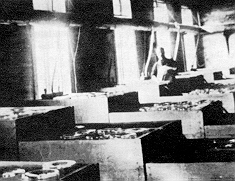
Table 1: Hatchery production, 1890-96
Year Hatched % Loss
1890 17 104 000 49.4
1891 39 650 000 49.8
1892 165 244 000 37.8
1893 201 435 000 35.0
1894 221 000 000 36.0
1895 188 000 000 24.0
1896 186 400 000 24.0
_____________________
Total 1 018 833 000
Source: Reports of the Department of Fisheries, 1895 and 1896
On one side was the "Chester apparatus," comprising forty-eight 3
ft. long by 20 inches wide by 22 inches high water-tight wooden
boxes arranged in rows, each row six inches higher than the
other. The three boxes in each row were separated by a walkway.
Six glass incubator cylinders, 9 inches by 18 inches and with a
hole drilled in the bottom, were located in each box. Ova
stripped from gravid females were cleaned, fertilized by mixing
with sperm, then placed into the incubators. Each cylinder was
covered with cheese cloth, and inverted in the boxes through
which sea water flowed from the cistern. Hatched yolk sac fry
were then transferred to larger wooden boxes for later release.
The "Macdonald apparatus" on the opposite side of the hatching
room was similar, and comprised four boxes 13 ft. long by 4 ft.
wide by 1 ft. high. Each was divided into twelve water-tight
compartments in which the incubator cylinders were placed. Every
compartment was further sub-divided into inlet, incubator, and
outlet sections. A siphon in the outlet compartment drew water
through the incubators and boxes. The hatchery was considered:
"... the largest of its kind in the world. It is fitted up with
all the latest improvements in its apparatus. Its situation is
unsurpassed, and it possesses every requisite to secure success
and to render it one of the greatest cod-breeding establishments
in the world." (29)
Nielsen was awarded a further five year contract in 1893 as
Superintendent of the now Department of Fisheries, reorganized
that same year from the Fisheries Commission. (30) Unfortunately,
the island's commercial banks collapsed in December 1894, forcing
the government to gradually decrease financing for the hatchery.
(31) While exact expenditures are uncertain, at least $10,000
seems to have been allocated for each of the first four
operational years, including Nielsen's salary and $4,000 for
initial construction. Annual input was increased to $20,000 in
1893. (32) Nielsen maintained the facility from his own funds
during 1896, despite having to resign in January of that year
(33) and return to Norway to convalesce from a severe attack of
asthma. (34)
Nonetheless, 186 million fry were hatched that year, leading
Augustus Harvey to consider funding operations for 1897. (35)
There is however no evidence of funds being made available or of
fry being produced. The building was sold to local merchant M.
Fred Woodman around 1906. He dismantled it and used the materials
to construct a general store at nearby New Harbour. (36)
It is impossible to objectively establish if the hatchery was
successful. Information is unavailable for example on fry
survival, however since they were released immediately after
hatching and before the onset of feeding, (37) it is unlikely
that their survival rate would have differed from naturally
produced fry. Fry would also have been produced if the brood
stock had been left in the wild. Various subjective opinions were
presented to the Government in an attempt to have funding of the
facility continue. The 1895 report of the Department of
Fisheries, for example, noted that there had been "large catches
of uniform small sized fish", and an "abundance of codfish of
various sizes, in the first part of the summer, in the head of
Trinity Bay, while at the same time there was none in either
Bonavista or Conception Bay, where the season's fishery fumed out
very poorly." (38) Further:
"It would be therefore unreasonable to expect, after such a short
trial as four years, a great and overwhelming increase of fish in
the water. A codfish requires four years to reach maturity ...
the increase can only be gradual, and time is required to
determine the value of such an important experiment. Still the
results in Trinity Bay are particularly encouraging, and afford
ample grounds for a continuance of the work." (39)
Large numbers of fish had also been seen in the vicinity of the
hatchery, and were so plentiful in fact that "some days they went
so near the land that the fishermen were able to take as many as
they pleased from the rocks on shore." (40) The government was
not convinced by such statements and the hatchery closed. An
unsubstantiated annual $428,400 profit was also suggested, based
on operating expenses of $1,000, a 5% survival of 200 million
annual production, and 70 fish to a quintal yielding 142,800
quintals at a low price of $3 per quintal. (41)
The short life of the Dildo hatchery followed a trend later
observed in other countries. Most serious criticism of such
hatcheries came from the scientific community, which demanded
more stringent examination of the results of releasing yolk sac
fry into the sea. Moses Harvey, for example, praised the work of
Nielsen up to 1893 in a paper (Chapter XXII) included in Prowse's
1895, A History of Newfoundland. Prowse, however, while
commending many of the initiatives taken by Nielsen and the
Commission - "in the practical part of its business," nevertheless
felt compelled to state that his "investigations do not confirm
Dr. Harvey's view that the artificial hatching of cod has been a
complete commercial success, either in Newfoundland, Norway, or
the United States." (42)
The few scientific investigations actually carried out were
inconclusive or contradictory. A hatchery opened in 1893 at
Dunbar, Scotland, closed in 1901; however the American hatcheries
continued until the 1950's. The Flodevigen hatchery was taken
over by the Government of Norway in 1918, and operated as a
fishery research establishment until 1971 when it became the
Flodevigen Biological station under the Institute of Marine
Research. Research on marine fish development and rearing
continues. (43)
OTHER FISHERY INITIATIVES
Nielsen's contribution to Newfoundland and Labrador fisheries
extended far beyond the development of the cod hatchery. In 1890,
for example, he introduced a bait intelligence service, and
published a booklet on "The Cure of Codfish and Herring" of which
2,000 copies were circulated. The contents were sufficiently
far-sighted and detailed that it was reprinted in 1930 by the
Minister of Marine and Fisheries. The following year, he also
published "Brief Rules for the Packing of Herring", which
emphasised the need for accumulation of fishery statistics in
order to better regulate the industry, and at the request of
Conception Bay merchants circumnavigated the island to locate
feeding shoals of herring. Nielsen's scientific work and
objectives also attracted the attention of the newly arrived
Wilfred Grenfell who invited him in 1892 "to join him in the
Albert as soon as the hatchery had closed up for the season, so
that together they could observe currents and estimate fish
stocks." (44)
In 1893 he recommended marking, registration and inspection of
cod traps, attempted to introduce Prince Edward Island oysters
into estuarine ponds in Conception and Placentia Bays, built the
island's first bait refrigerator at Burin, erected a model smoke
house on Sound Island, Placentia Bay, and introduced a patented
Norwegian barrel for preserving bait herring. In 1895, he
published instructions for the manufacture of cod liver oil, and
in 1896 suggested building salmon ladders around falls on
breeding rivers and the introduction of Pacific salmon to
Newfoundland. He also used artificial propagation methods in an
attempt to increase lobster stocks, developing floating egg
incubators which were placed in many of the bays. (45)
Nielson's pioneering fisheries work was also recognised by the
Government of France, which in 1897 conferred on him the
designation of Officer d'Acadenne in recognition of the relevance
of his work to St. Pierre fisheries. (46)
DEVELOPMENT OF MODERN SHORE STATION WHALING
The friendship and working partnership between Nielsen and the
Harveys culminated in the development of modern shore station
whaling in Newfoundland and Labrador, an industry which was to
sporadically exist until 1972 when the Government of Canada
prohibited commercial whaling. Modern whaling had begun in
Newfoundland and Labrador with the arrival of Basque whalers on
the Labrador coast in the early 16th century. Hunting later
continued with American vessels operating in coastal waters
during the 18th-19th centuries, by Peter LeMessurier and Company
and later Newman and Company at Gaultois, (47) and through small
scale opportunistic catching by local fishermen. (48)
Catching methods were revolutionized in the mid-1860's by the
development and use in Norway of steam catchers firing harpoons
fitted with explosive grenades. Species which had hitherto
escaped attack now had little chance, with the result that
Norwegian coastal stocks were rapidly depleted. Norwegian whalers
thus sought new stocks to hunt, and expanded operations westwards
to Iceland in 1883 and to the Faroe Islands in 1894. Newfoundland
was favourably positioned to receive this expanding industry;
local stocks appeared abundant, a Norwegian (Nielsen) with
fisheries and undoubtedly a knowledge of whaling was available,
and local merchants recognized the financial rewards possible.
(49)
On 29 December 1896, the Harveys therefore incorporated the Cabot Steam Whaling Co. Ltd. with Nielsen as whaling manager, (50) the first company in North America to use the new Norwegian whaling techniques which were to later revolutionist global whaling. Local and Norwegian entrepreneurs contributed funds (Table 2), the latter through Nielsen's initiatives. He also ordered a catcher Cabot (Figs. 3 and 4) built by Nylands Verksted of Christiania (Oslo). Whaling began under Nielsen's direction in June 1898, when Cabot under her Norwegian master, Captain Bull, and crew killed the first whale taken in "modern" North American whaling Nielsen also supervised construction of the company's first shore station, at Snook's Arm, Notre Dame Bay (Figs. 5 and 6), in August 1898 and the second at Balaena, near Macallum in Hermitage Bay (Fig. 7), in early 1899. (51)
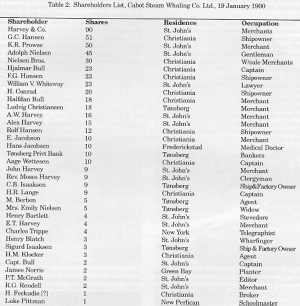
The Cabot Steam Whaling Co. Ltd. was initially highly successful leading other Newfoundland entrepreneurs to quickly form companies. (52) Unregulated hunting until 1902 extensively depleted whale stocks, and catches began to decline after the 1904 season, contributing to a gradual decline in the industry until temporary cessation of the operations in 1916. Whaling continued sporadically thereafter until 1972, when the factories at South Dildo and Williamsport closed.
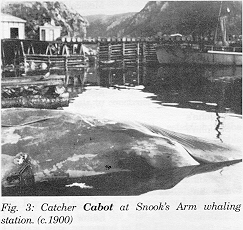
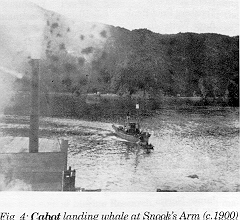
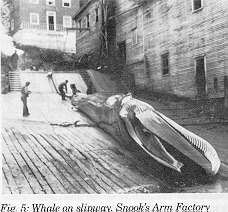
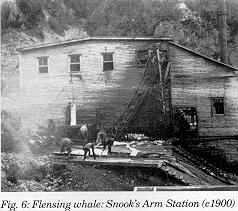
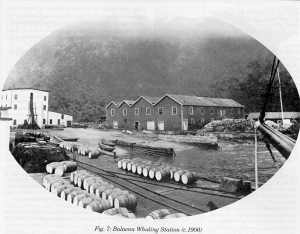
CONCLUSION
The presence of Adolph Nielsen in Newfoundland and Labrador
provided the impetus for development of new perspectives on a
variety of local fisheries, particularly through the introduction
of improved methods, regulations, and "scientific" initiatives.
(53) His work, however, proved stressful, and was often opposed
by various segments of the population. (54) His marriage may also
have been affected, it being reported in 1903 that "his wife, who
resided here, with their daughter, left for Norway five years
ago, to educate the little girl, and he has not seen them since."
(55)
Nielsen also did not see the whaling industry which he had helped to start expand to twenty-two stations (Fig 8). He died suddenly of a further asthma attack at the Crosbie Hotel, St. John's, on 1 November 1903, and was buried in the General Protestant Cemetery where his headstone is still visible (Fig 9). (56) Thus ended an important Norwegian contribution to maritime resource exploitation in Newfoundland and Labrador, a contribution which continues in other forms to the present day.
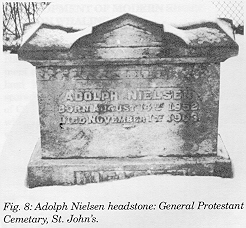
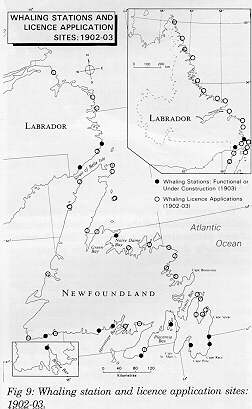
This paper emanates from an ongoing study funded by the Institute
of Social and Economic Research, Memorial University of
Newfoundland, and the Social Sciences and Humanities Research
Council of Canada. Photographs were provided by the National
Museum of Natural History, Smithsonian Institution, the
Provincial Archives of Newfoundland and Labradar, L. George, S.
Goddard and C. Sanger. Particular thanks are due to Gary McManus,
Memorial University Cartographic Laboratory, Department of
Geography, for preparing the map, and Sharon Wall for typing the
manuscript.
NOTES
1. Ryan, S. Fish out of Water: The Newfoundland Salt Fish Trade 1814-1914, St. John's: Breakwater, 1986.
2. Report of the Fisheries Commission Appointed to Investigate the Operations of Fisheries Departments in other Countries, St. John's, 1888, 1. See also, Evening Mercury, 30 July 1887.
3. Evening Mercury, 16 August 1887.
4. Report of the Fisheries Commission, 1888, op.cit.
5. See for example, Aldrich, F.A., We Are Now in Stormy Waters, Moses Harvey Inaugural Lecture, Memorial University, 1990.
6. Evening Mercury, 3 August 1887.
7. Solemdal, P. et al., "The Cod Hatchery in Flodevigen - Background and Realities," Flodevigen rapportser, 1, 1884.
8. Evening Mercury, 1, 3, 4, 5 and 6 August 1887.
9. Harvey, Moses. Newfoundland as it is in 1894. A Handbook and Tourist's Guide, St. John's, 1894, 100-101. Report of the Fisheries Commission, 1888, op. cit.
10. Report of the Fisheries Commission, 1888, ibid.
11. Loc. cit.
12. Loc. cit.
13. "Second Report of the Fisheries Commission," Newfoundland Sessional Papers, 1889, 614-615.
14. Loc. cit.
15. Report of the Fisheries Commission, 1888, op. cit.
16. Loc. cit. and "Second Report of the Fisheries Commission," 1889, op. cit, 615.
17. Evening Mercury, 15 September 1888.
18. "Second Report of the Fisheries Commission," 1889, op. cit, and Whiteway, L. "Inception of the Newfoundland Department of Fisheries," Newfoundland Quarterly, LV, no. 2 (June 1956), 29-43.
19. Evening Mercury, 15 September 1888.
20. Ibid., 30 November 1888.
21. Loc. cit.
22. "Mr. Adolph Nielsen, Report of his Journey Around the Heads of Conception, Trinity and Placentia Bays." Evening Telegram, 15 April 1889. For additional details on the selection of Dildo Island and the construction and early operation of the hatchery, see Report of the Fisheries Commission 1889, St. John's, 1890 and "Annual Report for 1893, Department of Fisheries," in Journal of the House of Assembly of Newfoundland, 1st Session, 17th General Assembly, 1894, 236-248. Site selection may have been influenced by the fact that the Acting Chairman of the 1887 Commission, Ellis C. Watson, was legislative member for the Trinity District which included Dildo Island. Gagnon, J.M., and Haedrich, R.L. Potential for Cod Ranching in Newfoundland: A Historical and Scientific Review. Report to the Minister of Fisheries, Province of Newfoundland and Labrador, 15 July 1991.
23. "Second Report of the Fisheries Commission," 1889, op. cit.
24. "An Act to provide for the formation of a Fisheries Commission and for other purposes," The Royal Gazette, 2 July 1889.
25. Report of the Fisheries Commission 1889, op. cit.
26. Gagnon, J.M. and Haedrich, R.L. 1991, op. cit. The operation of the hatchery, events leading to its construction and Nielsen's involvement have been summarized by Michael Harrington, "Offbeat History," Evening Telegram, 19 October and 16 November 1987.
27. Report of the Fisheries Commission 1891, St. John's, 1892.
28. Report of the Fisheries Commission 1889, op. cit.
29. Loc cit.
30. Louise Whiteway, op. cit., and "Report of the Department of Fisheries, 1897," Journal of the House of Assembly, St. John's, 1898.
31. "Report of the Department of Fisheries, 1896," Journal of the House of Assembly, St. John's, 1897.
32. Gagnon, J.M and Haedrich, R.L., op. cit.
33. "Report of the Department of Fisheries, 1896," op. cit.
34. Evening Telegram, 29 April 1896. The need to work in damp and cold weather" was credited as the cause of his asthma. See for example, Evening Herald, 2 November 1903.
35. "Report of the Department of Fisheries, 1897," op. cit.
36. George, L, quoted in Gagnon and Haedrich, op. cit.
37. Goddard, S. "Cod Farming in Newfoundland," Fish Farming International, 15, no. 7 (July 1988), 18-19.
38. "Report of the Department of Fisheries, 1895," Journal of the House of Assembly, St. John's, 1896.
39. Loc. cit.
40. Loc. cit.
41. Loc. cit.
42. Prowse, D.W. A History of Newfoundland from the English Colonial and Foreign Records, London, MacMillan and Co., 1895, 650-651.
43. Solemdal, 1984, op. cit; and Gagnon and Haedrich, op. cit.
44. Rompkey, R. Grenfell of Labrador: a Biography, Toronto: University of Toronto Press, 1991, 47.
45. These and other Nielsen initiatives are described in Harvey, M., op. cit. 165; Report of the Fisheries Commission, 1891, op. cit. 19-20; Report of the Department of Fisheries, 1894, op. cit. 30-39; "Report of the Department of Fisheries, 1896," op. cit. 312; Report of the Newfoundland Fisheries Research Commission, 1931, St. John's, 1932, 12-15; Daily Colonist, 15 and 16 January 1891; Daily News, 16 June and 5 July 1894; and Evening Herald, 26 September 1890.
46. Evening Telegram, 24 April 1897; and Daily News, 26 April 1897.
47. Prowse, op. cit., 298-299.
48. Sanger, C. and Dickinson, A.B. "The Origins of Modern Shore-Based Whaling in Newfoundland and Labrador: The Cabot Steam Whaling Co. Ltd.: 1896-98," International Journal of Maritime History, vol. 1, no. 1 (June 1989), 129-157.
49. Loc. cit.
50. Loc. cit.
51. Dickinson, A.B. and Sanger, C.W., "Modern shore-based whaling in Newfoundland and Labrador, 1902-03," International Journal of Maritime History, vol. 2, no. 1 (June 1990), 83-116.
52. Sanger, C.W. and Dickinson, A.B., "Expansion of Regulated Modern Shore-Station Whaling in Newfoundland and Labrador, 1902-03," The Northern Mariner, vol. 1, no. 2 (April 1991), 1-22. The Newfoundland industry was also instrumental in the development of the British Columbia shore-based whale fishery after 1905. Sanger, C.W. and Dickinson, A.B., "They were Clannish as Hell": Origins of Modern Shore-Station Whaling in British Columbia - The Newfoundland Factor, Halifax: Oceans Institute of Canada, 1991.
53. Templeman, W. "Fisheries Research," Encyclopedia of Newfoundland and Labrador, vol. 2, St. John's, 1984, 167-168.
54. See for example, Daily News, 16 June 1894 and 26 April 1897.
55. Evening Herald, 2 November 1903.
56. Adolph Nielsen's death certificate can be found in the Vital Statistics Division, Newfoundland Department of Health, St. John's. See also the Evening Herald 2 November 1903; and Daily News, 2 November 1903.